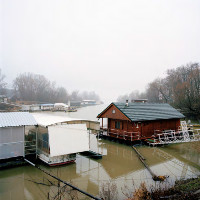| EVŽEN SOBEK - ŽIVOT V MODROM |
|
There are no translations available. V Stredoeurópsky Dom Fotografie Vás srdečne pozýva na výstavu českého fotografa Evžena Sobeka - Život v modrom, ktorá potrvá do 17.6.2012 Floating Context There are photographs that, when you look at them, do not make you begin to think about what has been depicted, but about how the photographer has made them (where he or she was standing, whether the photos were manipulated, and what took place in the darkroom). That’s generally a bad thing, but in documentary photography it’s outright disastrous. With his choice of topic, however, Sobek has, basically without a problem, avoided that potential risk. For, if there’s anything human beings are truly interested in, it’s human beings. But our fascination with all things human is not mere curiosity. It is rather the confrontation of animal spontaneity with what civilization has instilled in us. That’s why looking is exciting, not only as the act of looking, but also as a topic of study: a human being looking at a human being is a topic about which stacks of paper have been written. What determines this act of looking? And is our looking at something ethical, politically correct, non-sexist? Life in Blue is about human beings. The one who's looking is the photographer. By the way, how did the subjects react to the fact that they were being photographed? What did they conclude from that? The photographer surely explained to them that they were becoming part of a project that sought to capture a special trait, perhaps one that is outright national. Sobek’s photographic gesture has turned the people in the photos into representatives of a certain social phenomenon, which, though it was not painful, surely meant a shedding of anonymity and, hence, the acquisition of a certain status. So I wonder who the people are who file by in Sobek’s photographs? Are they the Resigned, who in this new era have used the means of escape that was formerly tried and tested by Socialist Man, creating hobby-worlds of their own design? Or are they the ones who have chosen an Alternative Lifestyle, distrustful of civil society, equal opportunity for all, corporate culture, and holidays abroad? To be honest, I don’t know, and it’s probably not really important. In any case, the mere possibility of this polarity demonstrates that Sobek’s Life in Blue has not only aesthetic and documentary qualities, but also a bit of the political. And how should one describe Sobek’s photographic style? It is a mixture of exquisite composition, the relaxed quality of holiday photography, the consistency of ethnographic documentary photography, seasoned with irony of a Surrealist kind. In short, it is a postmodern clash of the deadpan style and art photography. Sobek makes no secret of his acknowledgement of the ‘subjective documentary’ style that is so popular in this country nor does he conceal his being part of the wide international stream of adherents of the Düsseldorf School of Photography. These contemporary Encyclopédistes, concealing subtle meanings behind the masks of their photographs, produce works that are places to rest for people who are bombarded with tons of straightforward messages every day. I would rather not speculate, but I think that this sort of style would suit even those who carry on their lives in blue on the shores of the Nové Mlýny reservoirs. Jiří Pátek |











